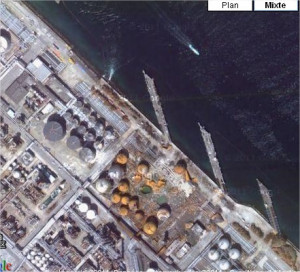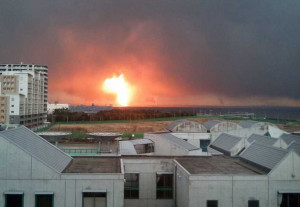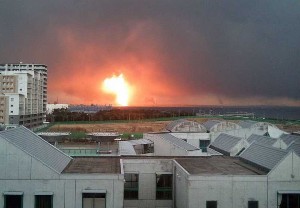A major earthquake (9 on the Richter scale) hits eastern Japan at 14:46, a leak on a LPG pipe is detected at 15 h 35 in a refinery located within a large petrochemical complex in the bay of Tokyo . At 15 h 48, the leak ignites and spreads to the adjacent spherical tanks stocking liquefied butane and butylene. The rapid development of the fire causes the fall of most tanks (broken foot support) and a cascade of BLEVE. Firefighters from the refinery, backed by the town firefighters arrived on site at 16:04 are unable to control the fire due to considerable heat flows. Their action is limited to the protection of nearby equipments (storage tank, steam cracker ..). Small fire which broke out on the neighboring polyethylene and polypropylene steam crackers are easily extinguished during the first night following the quake. The LNG park’s fire lasts 10 days before being extinguished. One person is serious injured and 5 others are slightly wounded. The refinery resumed full activity (excluding oil storage facilities) only 6 months later due to the damage caused on the refining units by the earthquake and its aftershocks in the following weeks (63> magnitude 6), causing losses in the order of 100 millions of Euros (2011). In the North east of Japan, another refinery is badly damaged by the earthquake and the resulting tsunami (ARIA 40258).
The initial leak of LPG, by crushing of a pipe, resulted from the collapse of an overhanging sphere filled with water for a hydraulic test after the 1st aftershock of the main earthquake. The main earthquake (acceleration of 0.1 m/s²) weakened the supporting structure by cracking the crosspieces, and then led to the failure of the support legs during the 1st aftershock of magnitude 7.2 (acceleration of 0.99 m/s²) at 3.15 pm. The design of the structure adapted to the seismic risk for a gas load did not take into account the overload due to the filling of the tank with water. In addition, the automatic safety shutdown of the gas transport circuit triggered by the seismometers was inoperative on this part of the network, as the automatic cut-off valve was shunted open following earlier problems with the pneumatic control. The temporary procedure of manually closing this valve pending repair could not be implemented due to a large LPG pool.
The operator is considering several measures:
- reduction of the duration of the water presence in the spheres in hydraulic tests (judged abnormally long during the accident) ;
- water surcharge of the capacity taken into account when designing the structures of the new spheres ;
- systematic isolation and draining of gas networks close to the spheres under hydraulic test ;
- Increasing the flexibility of new on-site gas transport networks to accommodate large multidirectional displacements during major earthquakes.
Translated with www.DeepL.com/Translator (free version)






